Enhancing the use of inversion structures in academic writing for english majors at Thai Nguyen university of education
Inversion is one of the factors contributing to the structure and grammar variety of a piece
of academic writing; however, as can be seen from the results academic writing tests at Thai Nguyen
University of Education (TUE), English majors rarely employ different inversion structures. This
research, therefore, was conducted to investigate the current situation of using inversion structures
among English majors at TUE, to discover the common difficulties related to inversion structures that
students have, to find out the causes of those difficulties as well as to give some suggestions to solve
the problems. A mixed-method research design (both qualitative and quantitative) was carried out
involving 5 English lecturers and 103 third-year and fourth-year English majors of TUE. The data
were collected via a test on inversion structures, writing analysis and questionnaires. The results of the
research reveal that English majors at TUE do not employ a variety of inversion structures in their
academic writing.
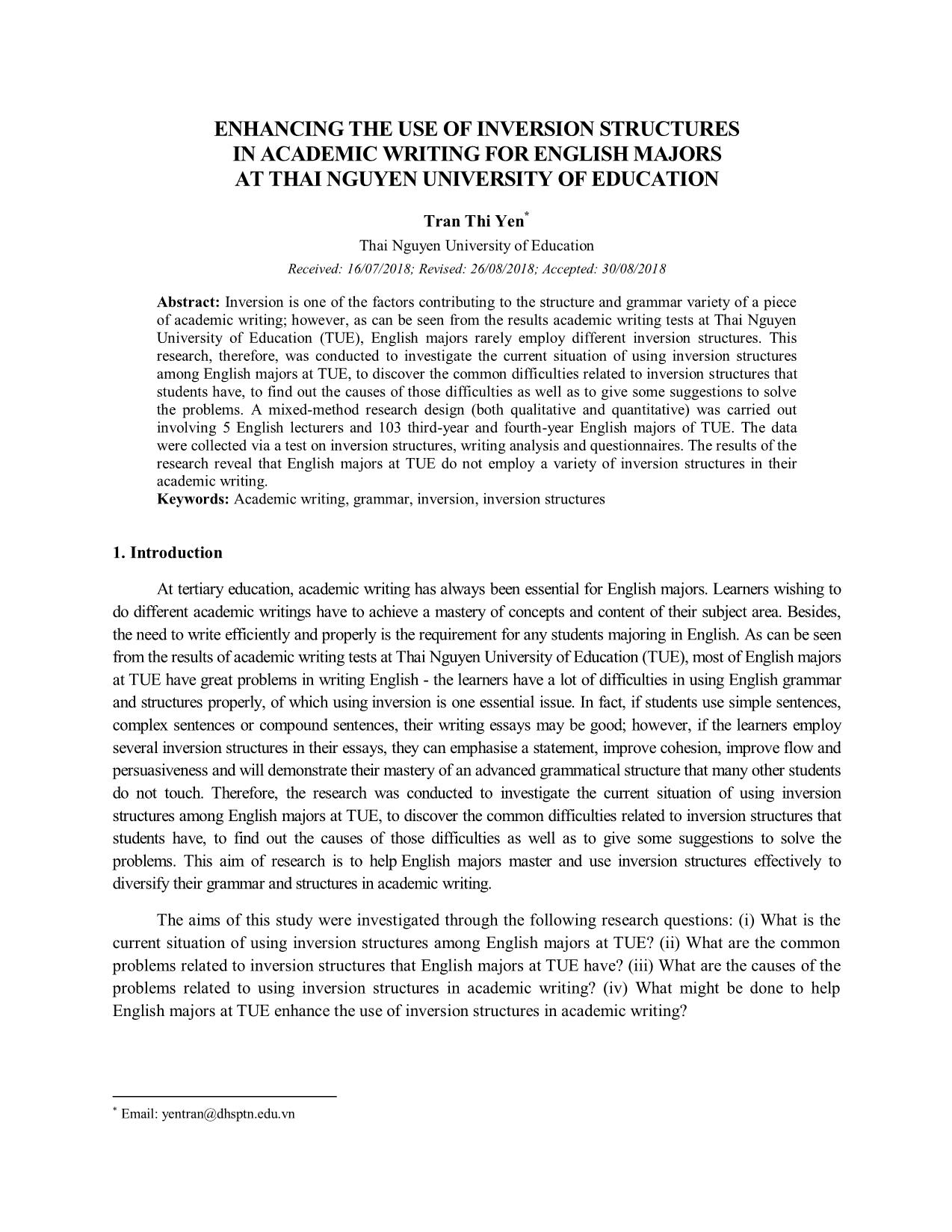
Trang 1
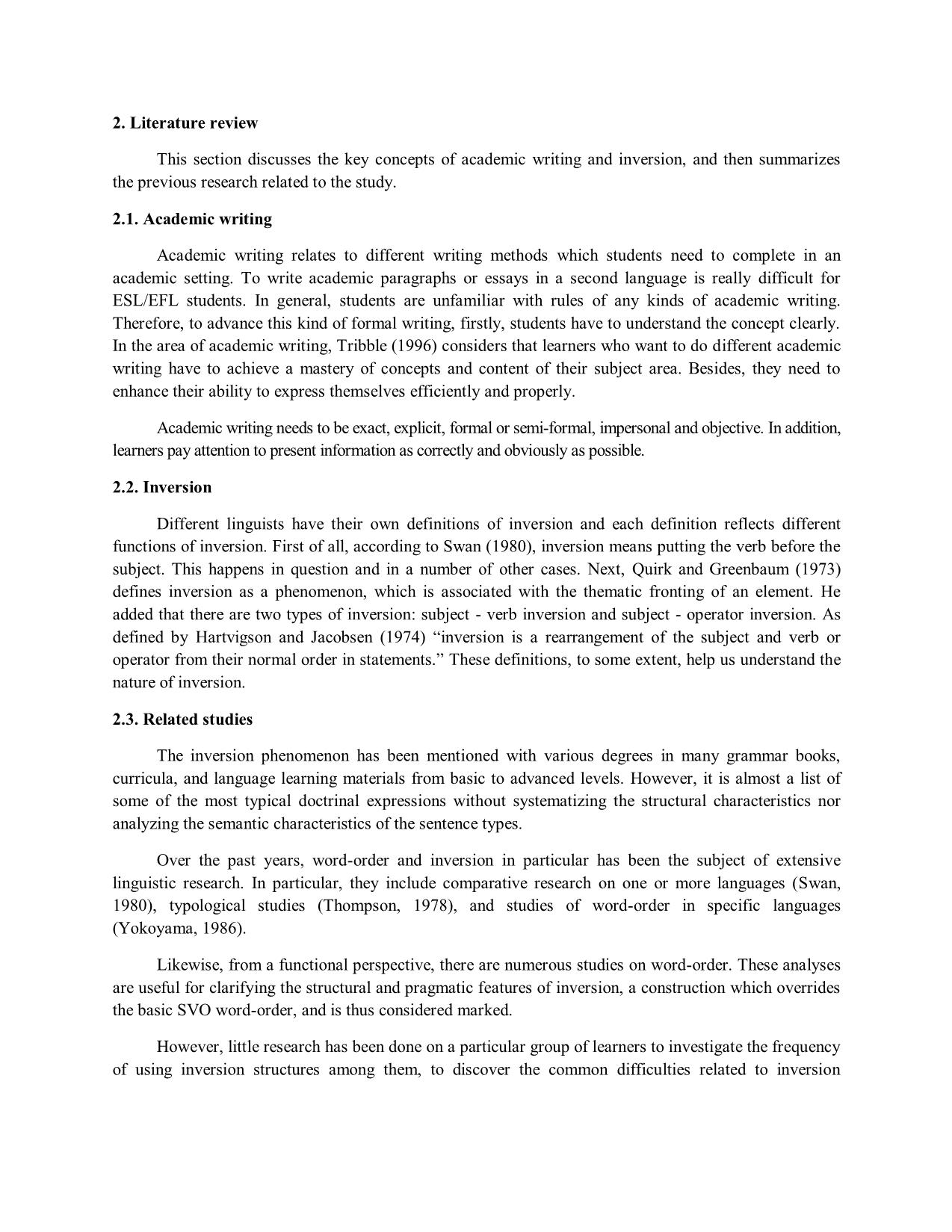
Trang 2
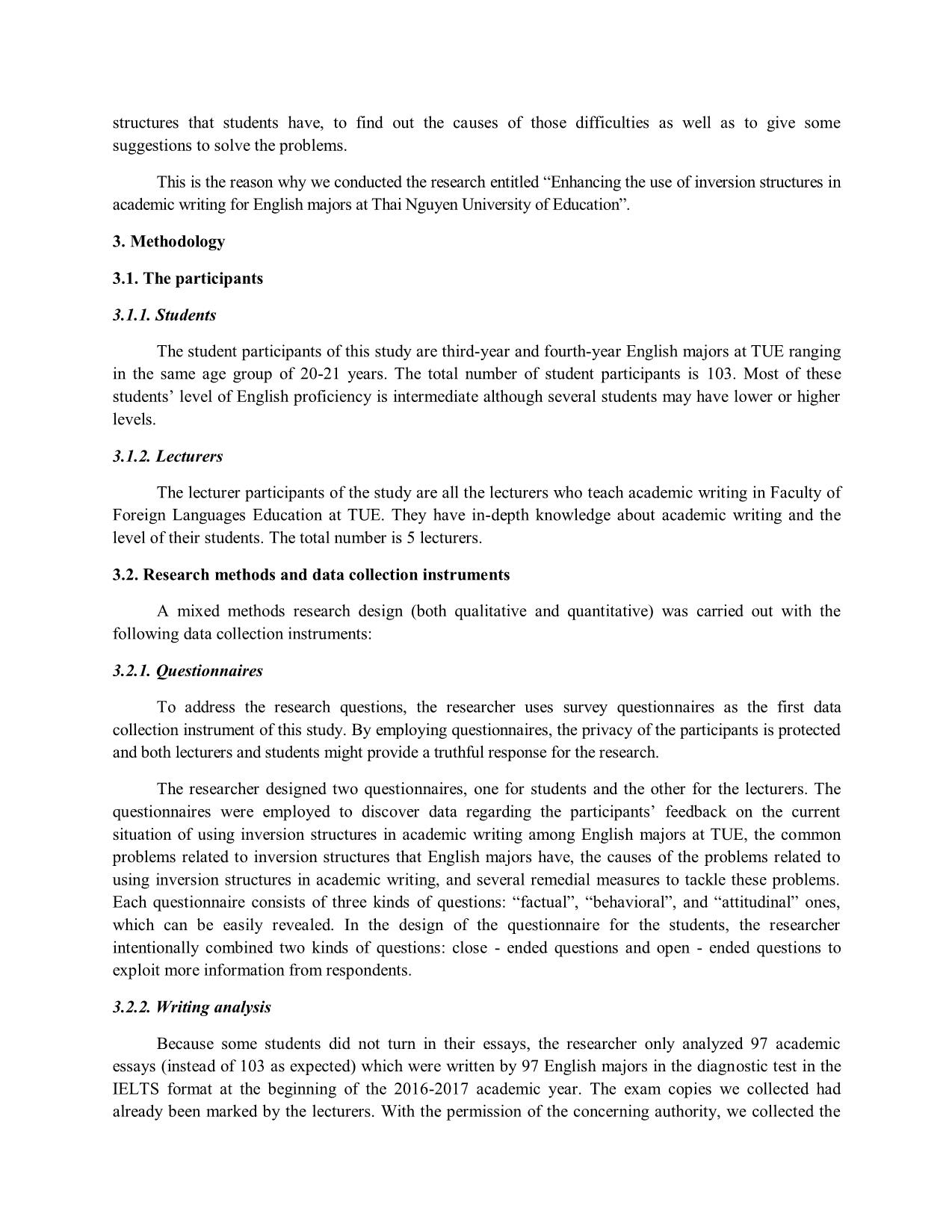
Trang 3
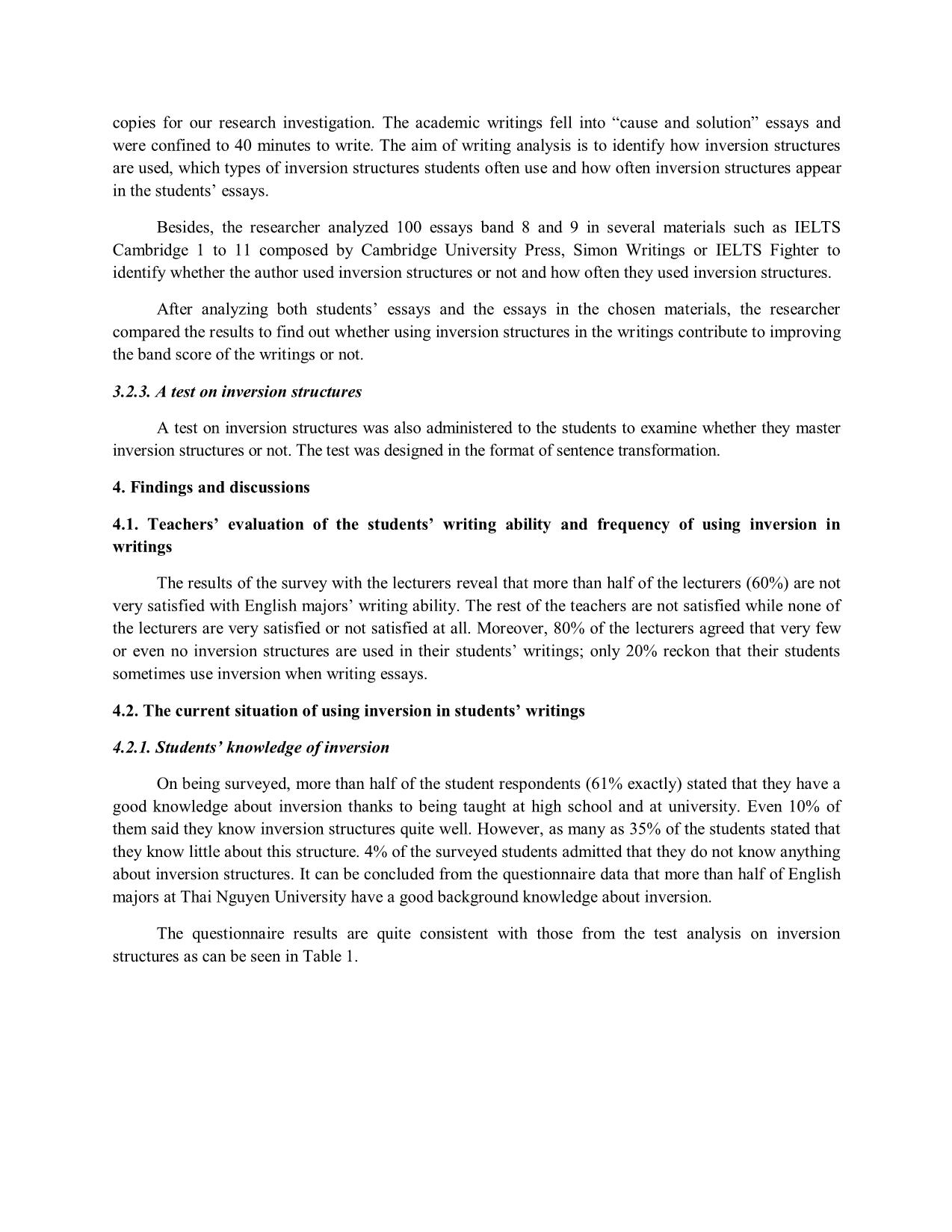
Trang 4
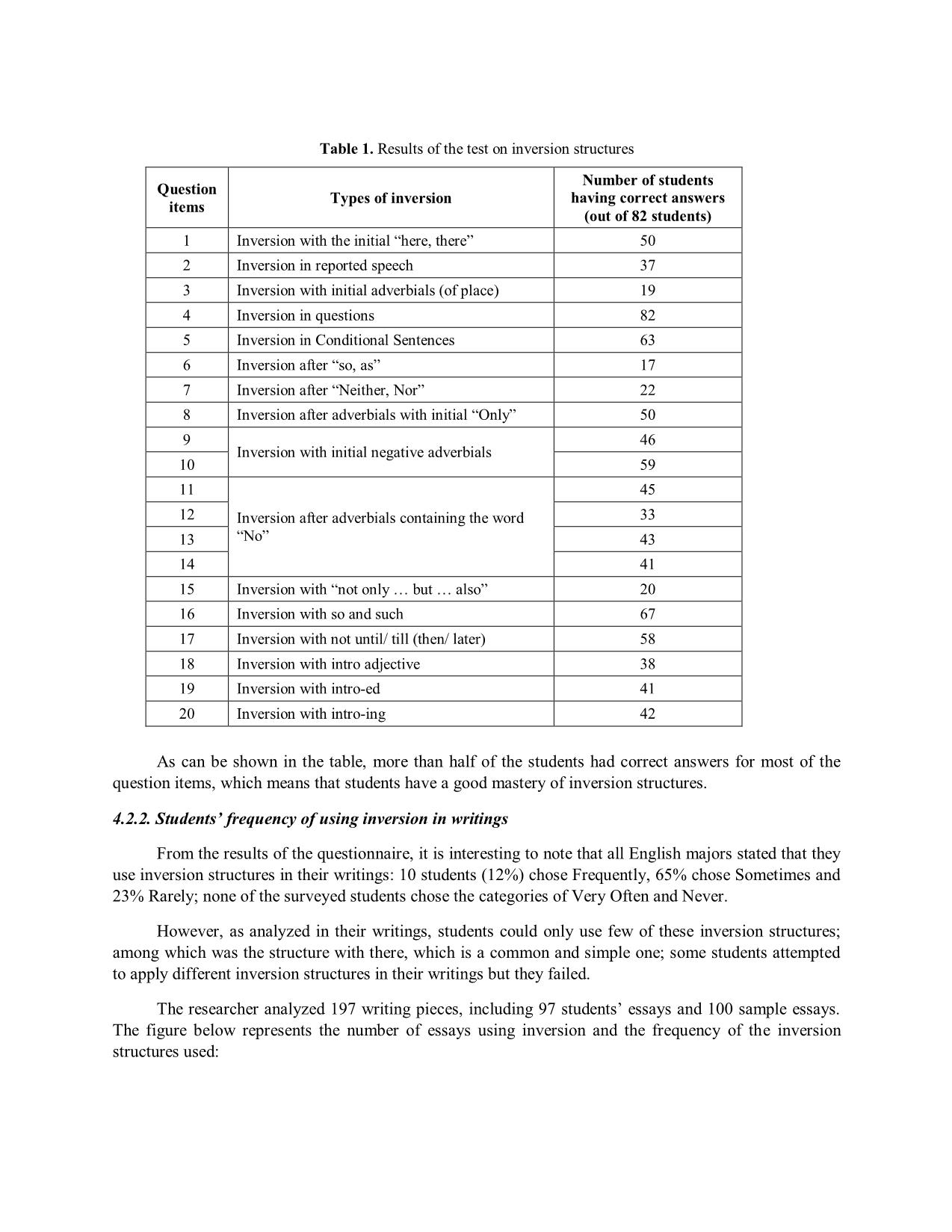
Trang 5
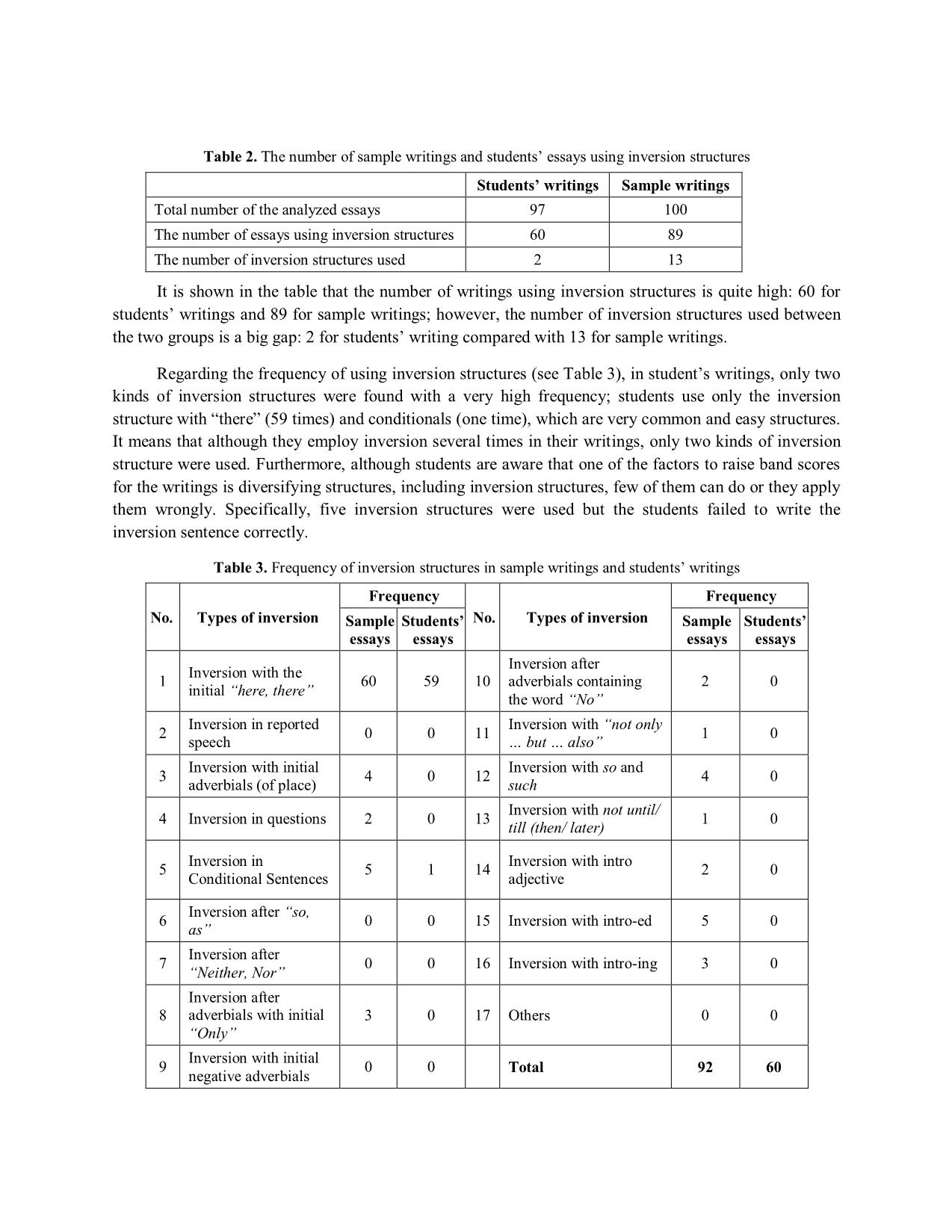
Trang 6
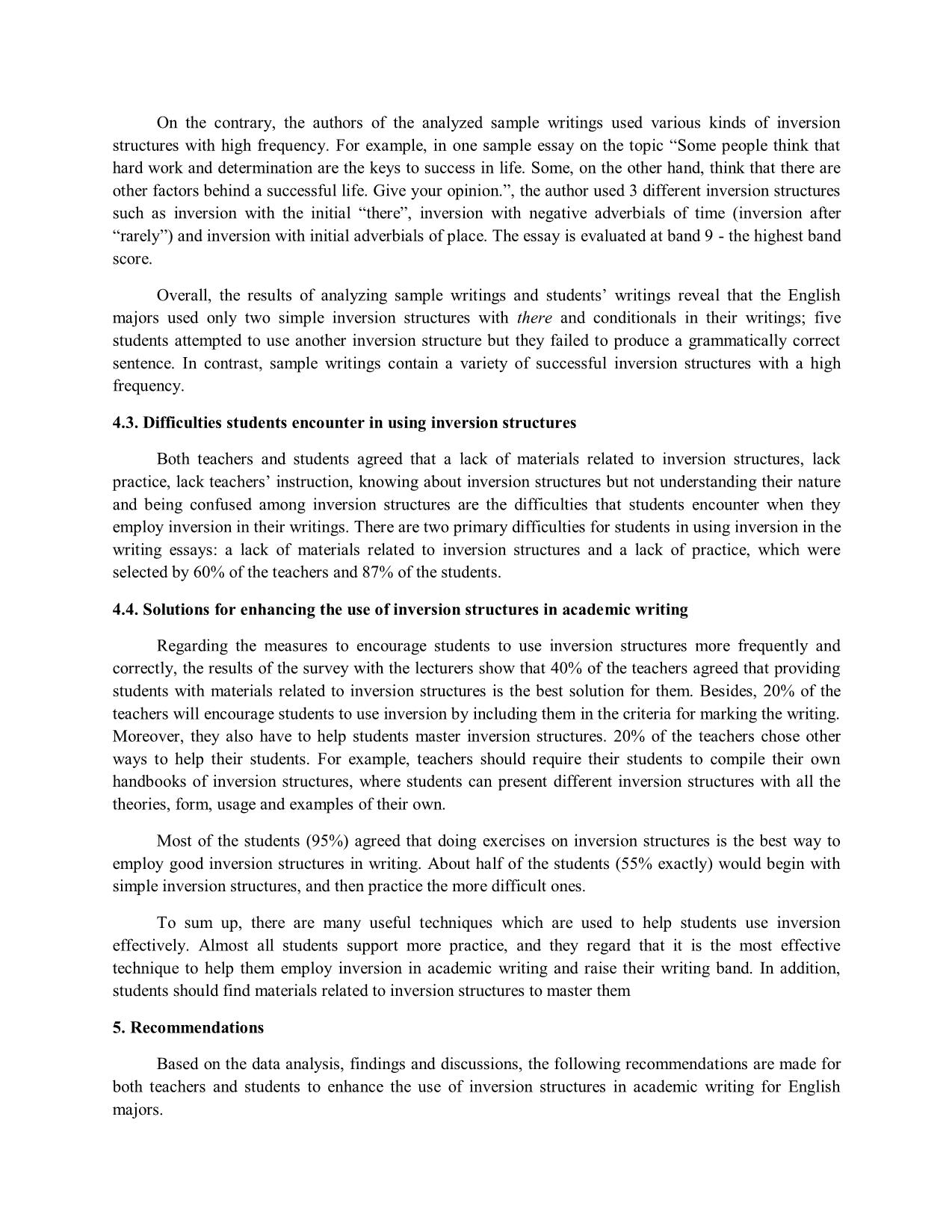
Trang 7
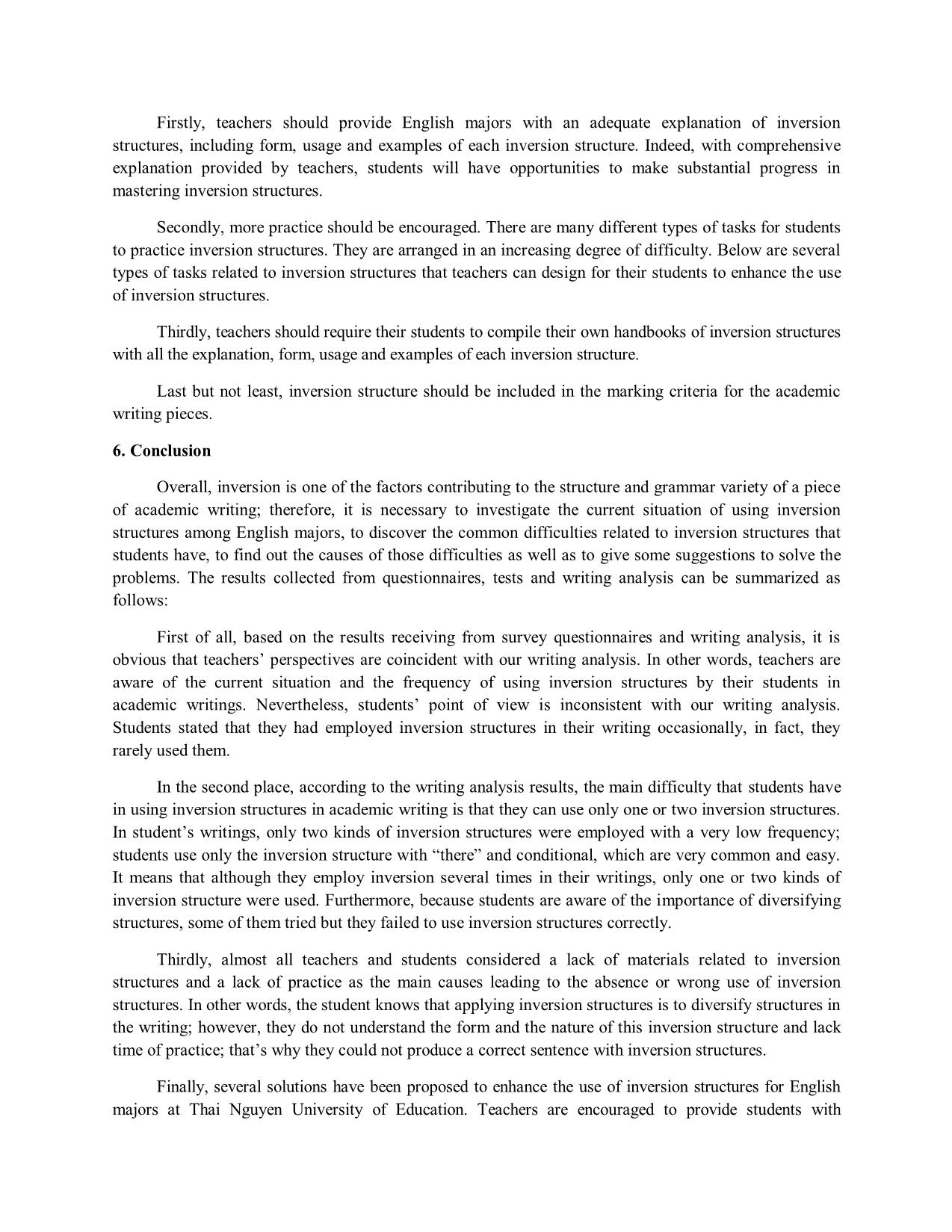
Trang 8
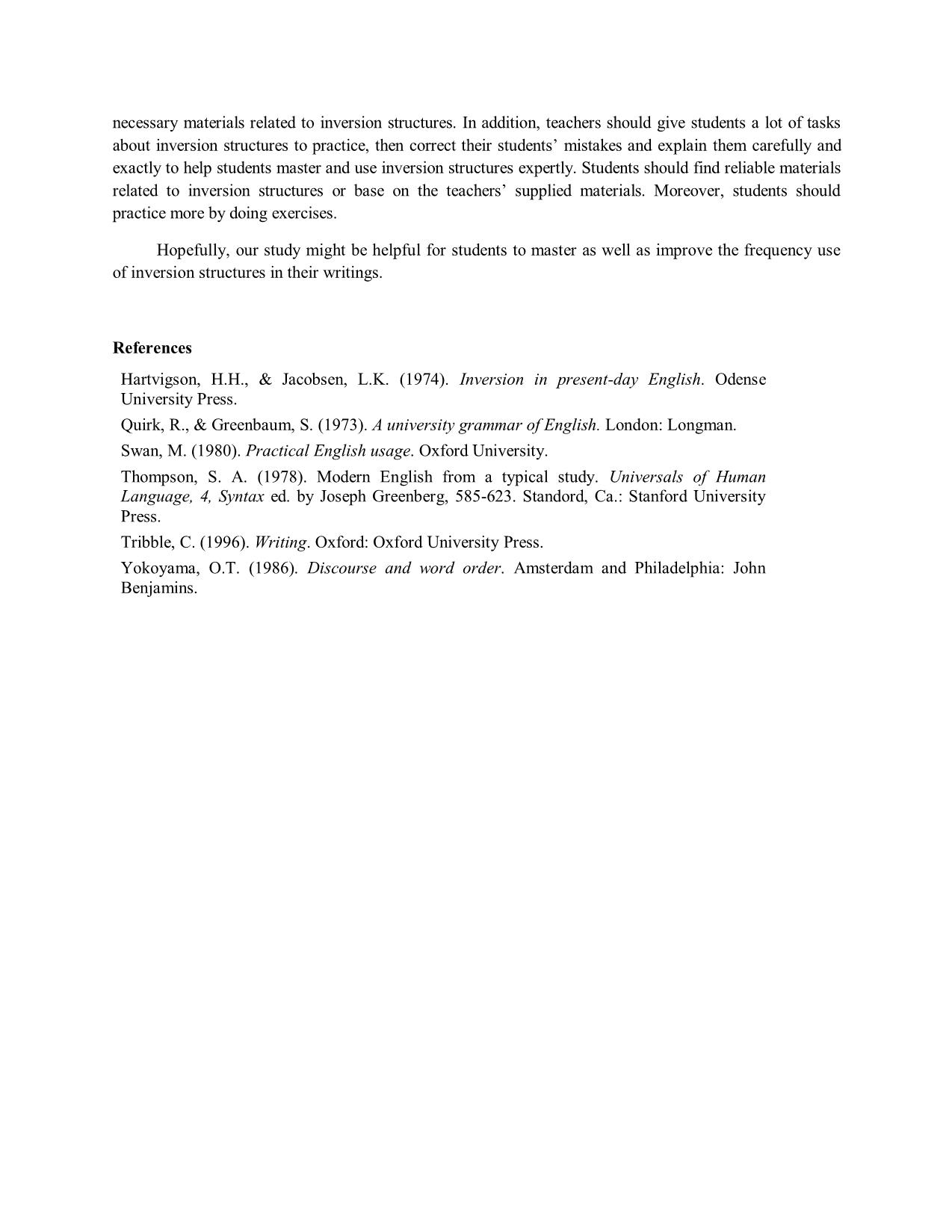
Trang 9
Tóm tắt nội dung tài liệu: Enhancing the use of inversion structures in academic writing for english majors at Thai Nguyen university of education
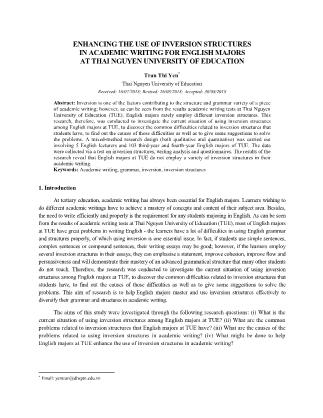
ENHANCING THE USE OF INVERSION STRUCTURES IN ACADEMIC WRITING FOR ENGLISH MAJORS AT THAI NGUYEN UNIVERSITY OF EDUCATION Tran Thi Yen * Thai Nguyen University of Education Received: 16/07/2018; Revised: 26/08/2018; Accepted: 30/08/2018 Abstract: Inversion is one of the factors contributing to the structure and grammar variety of a piece of academic writing; however, as can be seen from the results academic writing tests at Thai Nguyen University of Education (TUE), English majors rarely employ different inversion structures. This research, therefore, was conducted to investigate the current situation of using inversion structures among English majors at TUE, to discover the common difficulties related to inversion structures that students have, to find out the causes of those difficulties as well as to give some suggestions to solve the problems. A mixed-method research design (both qualitative and quantitative) was carried out involving 5 English lecturers and 103 third-year and fourth-year English majors of TUE. The data were collected via a test on inversion structures, writing analysis and questionnaires. The results of the research reveal that English majors at TUE do not employ a variety of inversion structures in their academic writing. Keywords: Academic writing, grammar, inversion, inversion structures 1. Introduction At tertiary education, academic writing has always been essential for English majors. Learners wishing to do different academic writings have to achieve a mastery of concepts and content of their subject area. Besides, the need to write efficiently and properly is the requirement for any students majoring in English. As can be seen from the results of academic writing tests at Thai Nguyen University of Education (TUE), most of English majors at TUE have great problems in writing English - the learners have a lot of difficulties in using English grammar and structures properly, of which using inversion is one essential issue. In fact, if students use simple sentences, complex sentences or compound sentences, their writing essays may be good; however, if the learners employ several inversion structures in their essays, they can emphasise a statement, improve cohesion, improve flow and persuasiveness and will demonstrate their mastery of an advanced grammatical structure that many other students do not touch. Therefore, the research was conducted to investigate the current situation of using inversion structures among English majors at TUE, to discover the common difficulties related to inversion structures that students have, to find out the causes of those difficulties as well as to give some suggestions to solve the problems. This aim of research is to help English majors master and use inversion structures effectively to diversify their grammar and structures in academic writing. The aims of this study were investigated through the following research questions: (i) What is the current situation of using inversion structures among English majors at TUE? (ii) What are the common problems related to inversion structures that English majors at TUE have? (iii) What are the causes of the problems related to using inversion structures in academic writing? (iv) What might be done to help English majors at TUE enhance the use of inversion structures in academic writing? * Email: yentran@dhsptn.edu.vn 2. Literature review This section discusses the key concepts of academic writing and inversion, and then summarizes the previous research related to the study. 2.1. Academic writing Academic writing relates to different writing methods which students need to complete in an academic setting. To write academic paragraphs or essays in a second language is really difficult for ESL/EFL students. In general, students are unfamiliar with rules of any kinds of academic writing. Therefore, to advance this kind of formal writing, firstly, students have to understand the concept clearly. In the area of academic writing, Tribble (1996) considers that learners who want to do different academic writing have to achieve a mastery of concepts and content of their subject area. Besides, they need to enhance their ability to express themselves efficiently and properly. Academic writing needs to be exact, explicit, formal or semi-formal, impersonal and objective. In addition, learners pay attention to present information as correctly and obviously as possible. 2.2. Inversion Different linguists have their own definitions of inversion and each definition reflects different functions of inversion. First of all, according to Swan (1980), inversion means putting the verb before the subject. This happens in question and in a number of other cases. Next, Quirk and Greenbaum (1973) defines inversion as a phenomenon, which is associated with the thematic fronting of an element. He added that there are two types of inversion: subject - verb inversion and subject - operator inversion. As defined by Hartvigson and Jacobsen (1974) “inversion is a rearrangement of the subject and verb or operator from their normal order in statements.” These definitions, to some extent, help us understand the nature of inversion. 2.3. Related studies The inversion phenomenon has been mentioned with various degrees in many grammar books, curricula, and language learning materials from basic to advanced levels. However, it is almost a list of some of the most typical doctrinal expressions without systematizing the structural characteristics nor analyzing the semantic characteristics of the sentence types. Over the past years, word-order and inversion in particular has been the subject of extensive linguistic research. In particular, they include comparative research on one or more languages (Swan, 1980), typological studies (Thompson, 1978), and studies of word-order in specific language ... inversion in writings The results of the survey with the lecturers reveal that more than half of the lecturers (60%) are not very satisfied with English majors’ writing ability. The rest of the teachers are not satisfied while none of the lecturers are very satisfied or not satisfied at all. Moreover, 80% of the lecturers agreed that very few or even no inversion structures are used in their students’ writings; only 20% reckon that their students sometimes use inversion when writing essays. 4.2. The current situation of using inversion in students’ writings 4.2.1. Students’ knowledge of inversion On being surveyed, more than half of the student respondents (61% exactly) stated that they have a good knowledge about inversion thanks to being taught at high school and at university. Even 10% of them said they know inversion structures quite well. However, as many as 35% of the students stated that they know little about this structure. 4% of the surveyed students admitted that they do not know anything about inversion structures. It can be concluded from the questionnaire data that more than half of English majors at Thai Nguyen University have a good background knowledge about inversion. The questionnaire results are quite consistent with those from the test analysis on inversion structures as can be seen in Table 1. Table 1. Results of the test on inversion structures Question items Types of inversion Number of students having correct answers (out of 82 students) 1 Inversion with the initial “here, there” 50 2 Inversion in reported speech 37 3 Inversion with initial adverbials (of place) 19 4 Inversion in questions 82 5 Inversion in Conditional Sentences 63 6 Inversion after “so, as” 17 7 Inversion after “Neither, Nor” 22 8 Inversion after adverbials with initial “Only” 50 9 Inversion with initial negative adverbials 46 10 59 11 Inversion after adverbials containing the word “No” 45 12 33 13 43 14 41 15 Inversion with “not only but also” 20 16 Inversion with so and such 67 17 Inversion with not until/ till (then/ later) 58 18 Inversion with intro adjective 38 19 Inversion with intro-ed 41 20 Inversion with intro-ing 42 As can be shown in the table, more than half of the students had correct answers for most of the question items, which means that students have a good mastery of inversion structures. 4.2.2. Students’ frequency of using inversion in writings From the results of the questionnaire, it is interesting to note that all English majors stated that they use inversion structures in their writings: 10 students (12%) chose Frequently, 65% chose Sometimes and 23% Rarely; none of the surveyed students chose the categories of Very Often and Never. However, as analyzed in their writings, students could only use few of these inversion structures; among which was the structure with there, which is a common and simple one; some students attempted to apply different inversion structures in their writings but they failed. The researcher analyzed 197 writing pieces, including 97 students’ essays and 100 sample essays. The figure below represents the number of essays using inversion and the frequency of the inversion structures used: Table 2. The number of sample writings and students’ essays using inversion structures Students’ writings Sample writings Total number of the analyzed essays 97 100 The number of essays using inversion structures 60 89 The number of inversion structures used 2 13 It is shown in the table that the number of writings using inversion structures is quite high: 60 for students’ writings and 89 for sample writings; however, the number of inversion structures used between the two groups is a big gap: 2 for students’ writing compared with 13 for sample writings. Regarding the frequency of using inversion structures (see Table 3), in student’s writings, only two kinds of inversion structures were found with a very high frequency; students use only the inversion structure with “there” (59 times) and conditionals (one time), which are very common and easy structures. It means that although they employ inversion several times in their writings, only two kinds of inversion structure were used. Furthermore, although students are aware that one of the factors to raise band scores for the writings is diversifying structures, including inversion structures, few of them can do or they apply them wrongly. Specifically, five inversion structures were used but the students failed to write the inversion sentence correctly. Table 3. Frequency of inversion structures in sample writings and students’ writings No. Types of inversion Frequency No. Types of inversion Frequency Sample essays Students’ essays Sample essays Students’ essays 1 Inversion with the initial “here, there” 60 59 10 Inversion after adverbials containing the word “No” 2 0 2 Inversion in reported speech 0 0 11 Inversion with “not only but also” 1 0 3 Inversion with initial adverbials (of place) 4 0 12 Inversion with so and such 4 0 4 Inversion in questions 2 0 13 Inversion with not until/ till (then/ later) 1 0 5 Inversion in Conditional Sentences 5 1 14 Inversion with intro adjective 2 0 6 Inversion after “so, as” 0 0 15 Inversion with intro-ed 5 0 7 Inversion after “Neither, Nor” 0 0 16 Inversion with intro-ing 3 0 8 Inversion after adverbials with initial “Only” 3 0 17 Others 0 0 9 Inversion with initial negative adverbials 0 0 Total 92 60 On the contrary, the authors of the analyzed sample writings used various kinds of inversion structures with high frequency. For example, in one sample essay on the topic “Some people think that hard work and determination are the keys to success in life. Some, on the other hand, think that there are other factors behind a successful life. Give your opinion.”, the author used 3 different inversion structures such as inversion with the initial “there”, inversion with negative adverbials of time (inversion after “rarely”) and inversion with initial adverbials of place. The essay is evaluated at band 9 - the highest band score. Overall, the results of analyzing sample writings and students’ writings reveal that the English majors used only two simple inversion structures with there and conditionals in their writings; five students attempted to use another inversion structure but they failed to produce a grammatically correct sentence. In contrast, sample writings contain a variety of successful inversion structures with a high frequency. 4.3. Difficulties students encounter in using inversion structures Both teachers and students agreed that a lack of materials related to inversion structures, lack practice, lack teachers’ instruction, knowing about inversion structures but not understanding their nature and being confused among inversion structures are the difficulties that students encounter when they employ inversion in their writings. There are two primary difficulties for students in using inversion in the writing essays: a lack of materials related to inversion structures and a lack of practice, which were selected by 60% of the teachers and 87% of the students. 4.4. Solutions for enhancing the use of inversion structures in academic writing Regarding the measures to encourage students to use inversion structures more frequently and correctly, the results of the survey with the lecturers show that 40% of the teachers agreed that providing students with materials related to inversion structures is the best solution for them. Besides, 20% of the teachers will encourage students to use inversion by including them in the criteria for marking the writing. Moreover, they also have to help students master inversion structures. 20% of the teachers chose other ways to help their students. For example, teachers should require their students to compile their own handbooks of inversion structures, where students can present different inversion structures with all the theories, form, usage and examples of their own. Most of the students (95%) agreed that doing exercises on inversion structures is the best way to employ good inversion structures in writing. About half of the students (55% exactly) would begin with simple inversion structures, and then practice the more difficult ones. To sum up, there are many useful techniques which are used to help students use inversion effectively. Almost all students support more practice, and they regard that it is the most effective technique to help them employ inversion in academic writing and raise their writing band. In addition, students should find materials related to inversion structures to master them 5. Recommendations Based on the data analysis, findings and discussions, the following recommendations are made for both teachers and students to enhance the use of inversion structures in academic writing for English majors. Firstly, teachers should provide English majors with an adequate explanation of inversion structures, including form, usage and examples of each inversion structure. Indeed, with comprehensive explanation provided by teachers, students will have opportunities to make substantial progress in mastering inversion structures. Secondly, more practice should be encouraged. There are many different types of tasks for students to practice inversion structures. They are arranged in an increasing degree of difficulty. Below are several types of tasks related to inversion structures that teachers can design for their students to enhance the use of inversion structures. Thirdly, teachers should require their students to compile their own handbooks of inversion structures with all the explanation, form, usage and examples of each inversion structure. Last but not least, inversion structure should be included in the marking criteria for the academic writing pieces. 6. Conclusion Overall, inversion is one of the factors contributing to the structure and grammar variety of a piece of academic writing; therefore, it is necessary to investigate the current situation of using inversion structures among English majors, to discover the common difficulties related to inversion structures that students have, to find out the causes of those difficulties as well as to give some suggestions to solve the problems. The results collected from questionnaires, tests and writing analysis can be summarized as follows: First of all, based on the results receiving from survey questionnaires and writing analysis, it is obvious that teachers’ perspectives are coincident with our writing analysis. In other words, teachers are aware of the current situation and the frequency of using inversion structures by their students in academic writings. Nevertheless, students’ point of view is inconsistent with our writing analysis. Students stated that they had employed inversion structures in their writing occasionally, in fact, they rarely used them. In the second place, according to the writing analysis results, the main difficulty that students have in using inversion structures in academic writing is that they can use only one or two inversion structures. In student’s writings, only two kinds of inversion structures were employed with a very low frequency; students use only the inversion structure with “there” and conditional, which are very common and easy. It means that although they employ inversion several times in their writings, only one or two kinds of inversion structure were used. Furthermore, because students are aware of the importance of diversifying structures, some of them tried but they failed to use inversion structures correctly. Thirdly, almost all teachers and students considered a lack of materials related to inversion structures and a lack of practice as the main causes leading to the absence or wrong use of inversion structures. In other words, the student knows that applying inversion structures is to diversify structures in the writing; however, they do not understand the form and the nature of this inversion structure and lack time of practice; that’s why they could not produce a correct sentence with inversion structures. Finally, several solutions have been proposed to enhance the use of inversion structures for English majors at Thai Nguyen University of Education. Teachers are encouraged to provide students with necessary materials related to inversion structures. In addition, teachers should give students a lot of tasks about inversion structures to practice, then correct their students’ mistakes and explain them carefully and exactly to help students master and use inversion structures expertly. Students should find reliable materials related to inversion structures or base on the teachers’ supplied materials. Moreover, students should practice more by doing exercises. Hopefully, our study might be helpful for students to master as well as improve the frequency use of inversion structures in their writings. References Hartvigson, H.H., & Jacobsen, L.K. (1974). Inversion in present-day English. Odense University Press. Quirk, R., & Greenbaum, S. (1973). A university grammar of English. London: Longman. Swan, M. (1980). Practical English usage. Oxford University. Thompson, S. A. (1978). Modern English from a typical study. Universals of Human Language, 4, Syntax ed. by Joseph Greenberg, 585-623. Standord, Ca.: Stanford University Press. Tribble, C. (1996). Writing. Oxford: Oxford University Press. Yokoyama, O.T. (1986). Discourse and word order. Amsterdam and Philadelphia: John Benjamins.
File đính kèm:
 enhancing_the_use_of_inversion_structures_in_academic_writin.pdf
enhancing_the_use_of_inversion_structures_in_academic_writin.pdf

